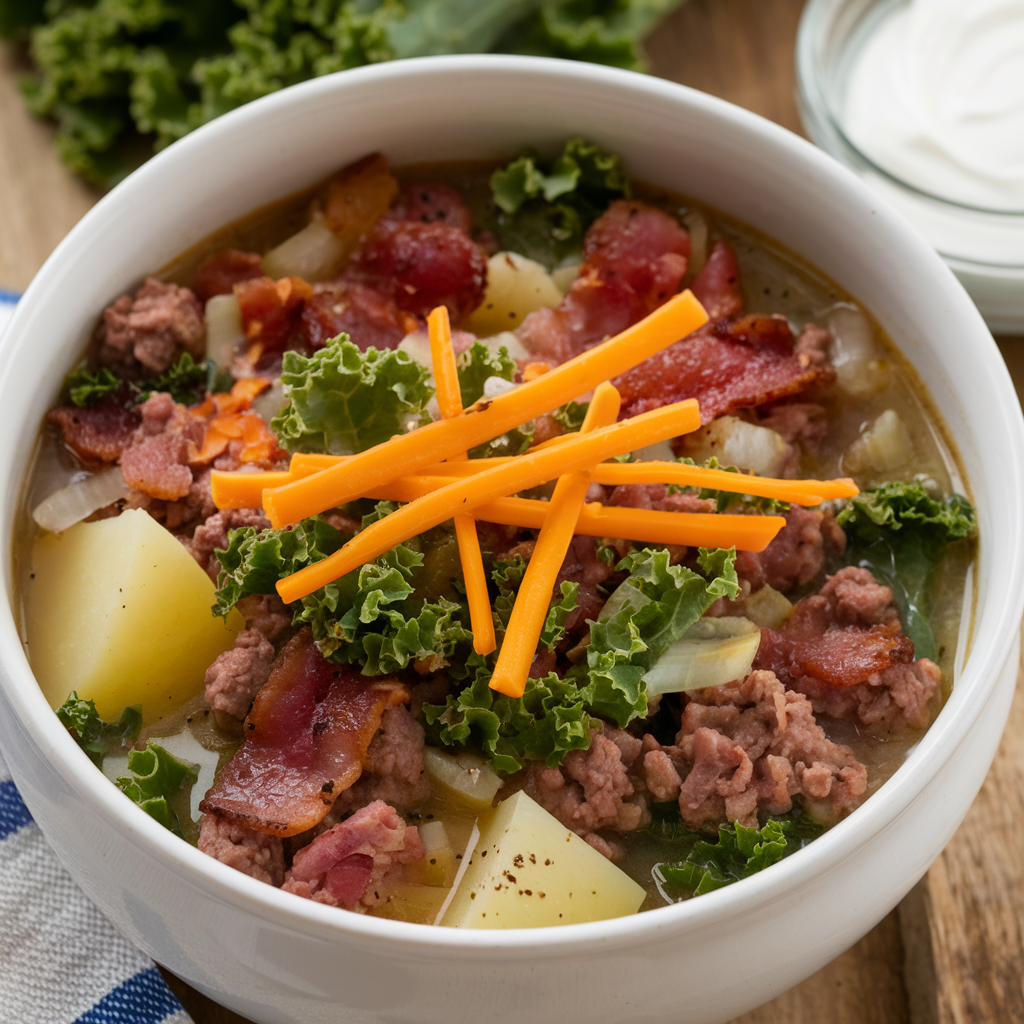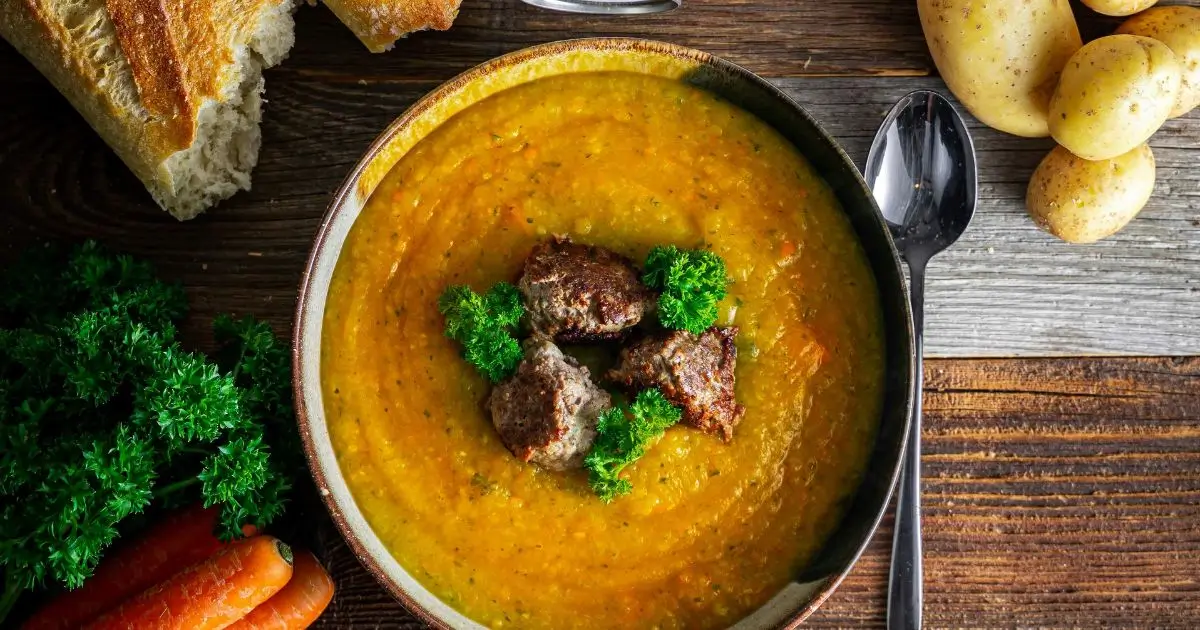Introduction to Hamburger Potato Soup
Hamburger potato soup is a classic comfort food that combines savory flavors with the warmth of a hearty meal. Traditionally, this dish consists of ground beef, tender potatoes, and a medley of vegetables, all simmered in a rich broth. The creamy texture and satisfying components make it a favorite among families, especially during colder months when warm, filling dishes are especially appealing.
The ingredients in hamburger potato soup vary by region and personal taste, but common elements include diced onions, carrots, celery, and sometimes even cheese, enhancing its richness. As it cooks, the potatoes soften, creating a delightful consistency that envelops the ingredients. This dish is not just filling; it also provides a sense of nostalgia for many, evoking memories of family dinners and cozy gatherings. Its comforting qualities have contributed to its widespread popularity, making it a staple in many households.
In recent years, there has been a growing interest in adapting traditional recipes to accommodate dietary preferences, particularly with the rise of low-carb and ketogenic diets. Many home cooks are exploring ways to reinvent this beloved soup by substituting some of the traditional ingredients, such as potatoes, with keto-friendly alternatives. This innovation allows fans of hamburger potato soup to enjoy its beloved flavors while adhering to their dietary needs.
By transforming the traditional hamburger potato soup recipe, individuals can create a satisfying meal that not only honors the essence of the original dish but also aligns with contemporary dietary lifestyles. This blend of tradition and modernity is key to understanding the allure of hamburger potato soup in various culinary settings.
Table of Contents
Understanding the Keto Diet
The ketogenic diet, commonly referred to as the keto diet, is a low-carbohydrate, high-fat dietary plan that has gained significant popularity in recent years. The primary objective of this dietary approach is to shift the body’s metabolism from relying on carbohydrates as its main source of energy to utilizing fats. This metabolic state, known as ketosis, can be achieved by drastically reducing carbohydrate intake while increasing the consumption of fats, alongside a moderate intake of protein. Typically, a keto diet involves a macronutrient distribution of approximately 70-75% fats, 20-25% protein, and only about 5-10% carbohydrates.
One of the main benefits of the ketogenic diet is its potential for weight loss, as the body burns stored fat for fuel when carbohydrate intake is limited. This change in energy utilization can also contribute to reduced hunger levels, making it easier for individuals to adhere to caloric limits without feeling deprived. Additionally, the keto diet has been studied for its possible effectiveness in managing certain medical conditions, such as epilepsy, type 2 diabetes, and even some neurodegenerative diseases.
While following a keto diet, it is essential for individuals to focus on whole, nutrient-dense foods that are low in carbohydrates. Foods to emphasize include healthy fats from sources like avocados, olive oil, and nuts, alongside adequate protein options such as eggs, meat, and seafood. Conversely, foods high in carbohydrates, such as bread, pasta, and various grains, should be avoided. This dietary framework can be adapted in various recipes, including popular dishes like hamburger potato soup, enabling those on keto to enjoy flavors while adhering to their nutritional goals.
Understanding these principles and benefits of the keto diet is crucial for anyone interested in modifying traditional recipes for lower carbohydrate consumption. Making adaptations, like transforming hamburger potato soup into a keto-friendly version, not only meets dietary restrictions but also allows for the enjoyment of comforting meals without compromising health objectives.
Traditional Ingredients to Avoid

Hamburger potato soup is often regarded as a hearty and comforting dish; however, some of its traditional ingredients may not align with a keto diet. The primary concern lies with potatoes, which are a staple in many soup recipes. Potatoes are high in carbohydrates, containing approximately 37 grams of carbs per 100 grams. This significant carbohydrate content poses a challenge for those seeking to maintain a ketogenic lifestyle, where the goal is to restrict daily carbohydrate intake to induce ketosis.
Additionally, many recipes for hamburger potato soup incorporate high-carb additives, such as flour-based thickeners and canned ingredients that may contain hidden sugars. These additives can further elevate the carbohydrate content of the dish, making it less suitable for individuals striving to limit their carb consumption. For example, a standard serving of commercial canned cream of mushroom soup can contain up to 10 grams of carbohydrates. As such, these traditional ingredients not only hinder the dietary goals of those on a keto regimen but also detract from the dish’s overall nutritional value.
Beyond potatoes and high-carb additives, other common ingredients such as corn and certain legumes also contribute excess carbohydrates, complicating efforts to prepare a satisfying, keto-friendly hamburger potato soup. By identifying these problematic components and understanding their impact, individuals can begin to explore suitable alternatives that maintain the essence of the original dish while aligning with their dietary preferences. Emphasizing low-carb vegetables and keto-friendly thickeners can help craft a delicious and nutritious variation that fits seamlessly into a ketogenic lifestyle.
Keto-Friendly Substitutes for Ingredients
When preparing a delicious hamburger potato soup that adheres to a ketogenic diet, it is essential to identify suitable substitutes for traditional ingredients. This not only helps to keep the carb count low but also preserves the rich flavor and satisfying texture that makes this dish a favorite among many. One of the primary ingredients to consider substituting is the potato. Instead of using regular potatoes, opt for cauliflower, which is a popular low-carb alternative. Cauliflower provides a similar texture when cooked and pureed, allowing you to create a creamy base without the extra carbohydrates associated with potatoes.
In addition to substituting vegetables, the choice of dairy can significantly impact the overall richness of the soup. Instead of cow’s milk, using heavy cream will enhance the flavor and provide a luxurious mouthfeel, making the dish more indulgent. Heavy cream has a higher fat content and lower carbohydrate levels, which aligns perfectly with ketogenic principles while avoiding the sweetness of regular milk. Furthermore, adding cream can help balance the flavors of the soup, ensuring that each spoonful is as satisfying as possible.
Moreover, incorporating low-carb vegetables such as zucchini, celery, and bell peppers can bring additional flavor dimensions and textures to your hamburger potato soup. These vegetables not only contribute to the overall nutrition of the dish but also keep the carb content at bay. It is also advisable to season the soup with herbs and spices, such as thyme, garlic, and pepper, to enhance the taste without adding unnecessary carbs. By experimenting with these alternatives, you can create a keto-friendly rendition of this classic soup, allowing those on a low-carb diet to enjoy a meal that is both flavorful and compliant with their dietary needs.
The Perfect Cooking Method for Keto Hamburger Potato Soup

When it comes to creating a delicious keto hamburger potato soup, the cooking method you choose can greatly affect the final outcome. Both stovetop and slow cooker options are viable, allowing for flexibility based on your schedule and preference.
To begin with the stovetop method, start by preparing your ingredients. Chop the low-carb vegetables such as cauliflower, which serves as a wonderful alternative to potatoes in a keto-friendly recipe. In a large pot, heat a tablespoon of olive oil over medium heat. Once the oil is hot, add diced onion and minced garlic, sautéing them until they become fragrant and translucent.
Next, add the ground beef to the pot. Ensure that the meat is cooked until browned, breaking it apart as it cooks. This step not only flavors the soup but also ensures that the meat integrates well with the other ingredients. After the meat is browned, incorporate the chopped cauliflower and any additional low-carb veggies like celery or bell peppers.
After the vegetables are added, pour in your choice of broth, preferably beef broth, as it complements the flavors well. Let it simmer for about 15 minutes, allowing the veggies to soften. For added creaminess, stir in heavy cream or a keto-friendly milk substitute towards the end of the cooking time. Season with salt, pepper, and your favorite herbs to taste.
If you prefer a slow cooker, the process is similarly simple. Sauté the onions and garlic first, as described above. Then, transfer them to the slow cooker along with the browned ground beef, chopped vegetables, and broth. Set the slow cooker on low for 6-8 hours, or high for 3-4 hours, allowing the flavors to meld beautifully. This method provides the added benefit of convenience, as you can set it and forget it.
The key to a successful keto hamburger potato soup lies in choosing quality ingredients and allowing enough time for the flavors to develop, whether using a stovetop or slow cooker method. Enjoy your hearty bowl of nourishment that aligns with ketogenic dietary goals.
Flavor Enhancements and Seasonings
When it comes to preparing a delicious keto hamburger potato soup, the right selection of seasonings and flavor enhancements can transform an ordinary dish into a culinary delight. A well-seasoned soup not only elevates the overall taste but also offers depth and complexity, making it enjoyable for everyone at the table. To achieve a balanced and flavorful hamburger potato soup, consider incorporating various herbs and spices that are compatible with a ketogenic diet.
Herbs such as thyme, rosemary, and parsley not only add freshness but also complement the hearty elements of the soup. Thyme, for example, provides an earthy flavor that pairs well with the richness of the hamburger meat. A sprinkle of dried rosemary can also enhance the complexity of the flavors, giving an aromatic twist to the dish. Fresh parsley can be used as a garnish, adding a vibrant color while also infusing the soup with a light, herby flavor.
In addition to herbs, spices can greatly enhance the depth of your hamburger potato soup. Ground black pepper is a staple that adds a subtle heat, while paprika can introduce a gentle smokiness. For those who enjoy a bit of spice, consider adding crushed red pepper flakes or cayenne pepper in moderation; these ingredients provide a kick that can contrast beautifully with the creamy texture often found in potato-based soups.
Also, do not overlook the importance of umami flavor enhancers. Ingredients such as garlic powder, onion powder, or even a splash of low-sodium soy sauce can help round out the flavors without adding unnecessary carbs. For a burst of acidity that balances the richness, a squeeze of lemon juice or a dash of vinegar just before serving can be a game changer. By thoughtfully selecting and blending these herbs, spices, and flavor boosters, your keto hamburger potato soup will not only meet dietary needs but also satisfy the palate.
Nutritional Information and Health Benefits
The keto hamburger potato soup provides a distinctive nutritional profile compared to its traditional counterpart. One of the primary advantages of moving to a keto-friendly version is the significant reduction in carbohydrate content. Typically, a traditional hamburger potato soup consists of potatoes that are rich in carbs, which can hinder those following a ketogenic diet. In contrast, the keto variant often utilizes low-carb alternatives such as cauliflower or zucchini, making it much more suitable for individuals aiming to keep their carbohydrate intake minimal while maximizing flavor.
In terms of macronutrients, a serving of keto hamburger potato soup generally contains a higher proportion of healthy fats and proteins, essential for those adhering to a keto lifestyle. This nutritional balance helps to foster ketosis—a metabolic state beneficial for weight management and fat burning. For instance, the incorporation of ground beef increases the protein content, contributing to satiety and muscle maintenance, crucial factors when pursuing weight loss.
Moreover, the ingredients utilized in the keto hamburger potato soup offer numerous health benefits. Vegetables such as spinach or kale can be introduced for added nutrition, providing vitamins and minerals without excessively raising carbohydrate levels. Furthermore, the inclusion of healthy fats, often sourced from butter or cream, enhances the absorption of fat-soluble vitamins such as A, D, E, and K.
Overall, this variation of hamburger potato soup not only aids in weight loss efforts through its low-carb format but also supports overall health by supplying essential nutrients. Adopting such a recipe contributes positively to dietary balance, especially for those pursuing a ketogenic lifestyle. By emphasizing healthier choices, keto hamburger potato soup can serve as a nourishing and satisfying meal option.
Serving Suggestions and Variations
When it comes to enjoying hamburger potato soup, particularly when prepared in a keto-friendly manner, presentation and accompaniments can enhance the overall dining experience. One common way to serve this delightful dish is with a garnish that not only adds flavor but also visual appeal. Consider topping your soup with shredded cheese, such as cheddar or mozzarella, which melts beautifully and offers a creamy texture. Alternatively, a dollop of sour cream can provide a rich, tangy contrast that complements the savory notes of the soup.
For those who appreciate fresh flavors, adding chopped green onions can introduce a slight crunch and brightness, elevating the taste. Additionally, crumbled bacon pieces can deliver a smoky, savory touch that aligns perfectly with the overall flavor profile of hamburger potato soup. If you are looking for a more substantial meal, serve the soup alongside a sliced avocado or a side salad composed of leafy greens and a keto-friendly dressing to further align with ketogenic dietary choices.
If you wish to explore variations of the traditional hamburger potato soup, consider incorporating ingredients that accommodate different preferences while maintaining the keto guideline. For example, swapping out traditional potatoes for cauliflower can create a lower-carb option that still retains the familiar comfort of potato soup. Another variation might include adding vegetables like zucchini or spinach, which can enhance the nutritional value without contributing significant carbs.
Ultimately, exploring different toppings and variations will allow you to tailor the hamburger potato soup to your individual tastes. By embracing creativity in garnishing and sides, you can transform a simple bowl of soup into an indulgent and satisfying meal that pleases both the palate and the dietary requirements of a keto lifestyle.
Conclusion and Encouragement to Try It Out
As we have explored throughout this post, the hamburger potato soup can be easily adapted to fit a ketogenic lifestyle while still delivering rich flavors. By substituting traditional ingredients with low-carb alternatives, such as using cauliflower instead of potatoes, you can create a hearty dish that satisfies your cravings without compromising your dietary goals. Moreover, incorporating nutritious vegetables and lean meats, like ground beef, enhances the meal’s overall nutritional profile.
We encourage you to experiment with this versatile recipe. You can customize your hamburger potato soup to suit your taste preferences, whether that involves adding spices, herbs, or other vegetables. Each adaptation adds a personal touch that not only enhances the flavor but also makes the dish uniquely yours. Consider documenting your cooking journey and sharing your variations, as it may inspire others to try their hand at crafting their own versions of this delightful soup.
Engaging with our blog community is another avenue to explore. We invite you to share your experiences in the comments section below, where you can exchange ideas and tips with fellow readers. Your insights and feedback can be invaluable for those looking to refine their recipes or even for beginners who might need guidance. Additionally, if you have friends and family who would appreciate a delicious keto-friendly meal, consider sharing this post with them. Together, we can foster a vibrant community centered around cooking and healthy living.
In closing, we hope you find joy in making this hamburger potato soup and tailoring it to match your lifestyle. It is both an enjoyable cooking endeavor and an opportunity to discover new flavors and health-conscious options. Happy cooking!
FAQs
Can you put meat in a soup?
Yes, meat is commonly used in soups to add flavor, protein, and richness. Beef, chicken, pork, and even seafood can be used, either cooked separately before being added or simmered directly in the soup for a deeper taste.
Which beef is better for soup?
Tougher cuts of beef with good marbling, such as chuck roast, short ribs, or shank, are ideal for soups. These cuts break down and become tender when slow-cooked, enriching the broth with flavor.
Can you cook beef in broth?
Yes, cooking beef in broth enhances its flavor and keeps it moist. Simmering beef in broth allows it to absorb the seasonings while also contributing richness to the soup.
How to improve bland potato soup?
To enhance a bland potato soup, add seasonings like garlic, onion, smoked paprika, or herbs such as thyme and rosemary. A splash of cream, shredded cheese, or crispy bacon can add depth. Adjust the salt and pepper to taste, and a bit of acidity from lemon juice or vinegar can also brighten the flavors.
What not to put in soup?
Avoid ingredients that can alter the texture or overpower the flavors, such as excessive salt, too much acid, or starchy vegetables that break down too much. Overcooked pasta, dairy added too early (which can curdle), and strong spices that don’t complement the base can also negatively affect the soup.
What is in potato soup?
Potato soup typically includes potatoes, broth (chicken or vegetable), onions, garlic, and cream or milk for richness. Additional ingredients can include cheese, bacon, sour cream, or herbs for extra flavor.
Is it OK to cook raw meat in soup?
Yes, it is safe to cook raw meat in soup as long as it reaches a proper internal temperature. Cooking it directly in the broth enhances the flavor, but for a clearer soup, you can brown the meat first to develop more depth and remove excess fat.
Have you tested our recipe yet?
There are no reviews yet. Be the first one to write one.

